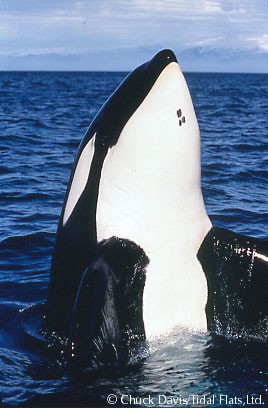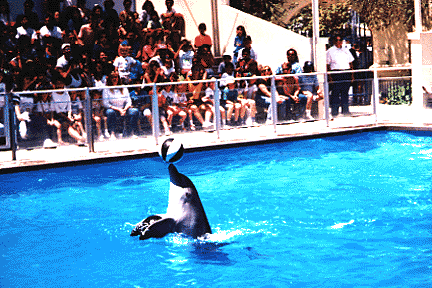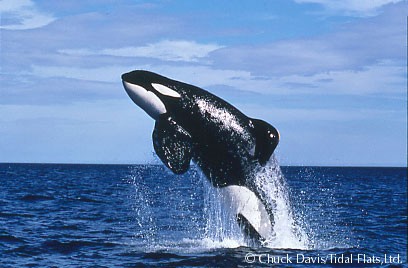Help Captive Orcas
Click here to learn more about how you can help captive orcas.
SeaWorld - The Tragic Truth About Orcas in Captivity
TILIKUM
February 2010
Tilikum, the orca, killed his trainer by drowning. We don't know why. He seems to have been fond of her and, from reports, she gave him some much-needed attention. He is the largest orca in captivity and lives in a woefully small tank unfit for even a small dolphin or porpoise. There is no tank anywhere that is large enough to provide an orca with quality of life.
Tilikum is 29 years old and the largest orca in captivity. In 1991, he was on display at Sealand of the Pacific in Canada when he and two other orcas killed a trainer in their pool by holding her under water. Tilikum did not instigate the attack started by an 8-year-old female named Haida, but he joined in. After this incident, he was sold to SeaWorld.
The reputation of the three SeaWorld facilities has been further tarnished as trainers continue to be injured or killed and orcas continue to live in deplorable conditions. Orcas have bumped, bitten, grabbed, dunked and held trainers on the pool bottom, in some cases leading to their death. What has been learned by the legacy of tragedy at SeaWorld and other aquaria? Nothing it appears; however, no record exists of an orca in the wild killing a human.
Another unnecessary human death has occurred and another orca will have his life further curtailed. Tilikum did no harm to anyone before being captured from his family pod in Iceland at the age of two. We do not know what an orca thinks or feels, but it is not too difficult to imagine that living in a tiny pool without adequate exercise or your family is not unlike the life of a human prisoner. The big difference is that orcas and other dolphin and whale prisoners are innocent of wrongdoing. Their crime is being valuable.
Tilikum has no one to talk to, since orca pods have their own dialect, and even another Icelandic orca and Tilikum could probably not communicate. In addition to his small tank size, which was shown on TV after Ms. Brancheau's death, Tilikum's living conditions will undoubtedly be further curtailed. His job at SeaWorld is to splash people.
If Tilikum had been allowed to live a normal life, he would have enjoyed his family's company, hunted cooperatively, and traveled up to a 100 miles a day in open water. Instead he lives in a confined situation with poor teeth and a bent-over dorsal fin, a condition that occurs in all captive male orcas and some females.
He weighs about 12,300 pounds, is 22.5 feet long, and no facility should be allowed to hold him or any dolphin or whale. The regulations for capturing orcas and dolphins from the wild are banned by the U.S. Government. But that does not stop aquaria captive breeding programs which lead to more imprisonment and death. In Tilikum's case he has fathered 13 calves, many of whom died. Corky at SeaWorld, San Diego, had seven calves and the longest one lived was 46 days.
SeaWorld and other aquaria have made millions charging very high rates for people to watch imprisoned animals do tricks. The real majesty of orcas can only be seen in the wild or by learning about their lives from videos, movies and websites.
The very least that should be done to improve their lives is to create considerate living conditions for them. A lasting goal would be open sea pens where orcas and other whales and dolphins would retire. Such pens would require huge sums of money but aquaria should foot the largest part of the bill. The goodwill created would be immense!
They might also create more of a tourist attraction than animals in concrete tanks. Revenue from aquaria shows has dropped since 9/11 and as society rejects what is perceived as animal cruelty. These facilities are eventually going to fail, so efforts should begin to retire aquaria and put the animals in open sea pens. Animals, whenever possible, should be returned to their family pods.
What is encouraging from this tragedy is the overwhelming support demonstrated for the plight of orcas in captivity. The majority of public comments shows that people understand captivity is wrong for dolphins, porpoises and whales.
Aquaria claims of education and research have no validity. We understand the lives of orcas only because they have been studied in the wild for over 40 years by biologists. Orcas live in their social families and never leave their "pod" except by death or capture.
Keiko, star of the Free Willy films, is cited as a failed example of an orca being returned to the wild. Conclusions are not reached by one example. His Icelandic family was not located before he was returned which might have made a big difference. The Captivity – Marine Mammals section of our website gives examples of animals who have returned to the wild.
The U.S. should set an example by phasing out aquaria and no harm - beyond what has already been done to this animal - should come to Tilikum.
The Blackstone Group, with headquarters in New York City, is the parent company of the three SeaWorlds since they purchased them in late 2009. They have in their possession animals that were forcefully taken from their family pods (Tilikum and Corky, SeaWorld, San Diego). It is time to find ways to phase out aquaria and other animals for amusement diversions, such as swim-with-dolphin programs in the United States. Other countries have phased out aquaria as they recognize that enlightened people are not accepting captive whales and dolphins as entertainment.
EMAIL or WRITE:
Hamilton E. James, President & COO
The Blackstone Group
Executive Offices
345 Park Avenue, 31st Floor
New York, NY 10154
Phone: (212) 583-5000
Fax: (212) 583-5749
Email: info@blackstone.com
SeaWorld, Orlando, Florida
Email: Sea World - Orlando FL
Lolita
Lolita, originally named Tokitae, is the last surviving orca of 45 members of the Southern Resident community of orcas that were captured and delivered for display in marine parks between 1965 and 1973. Thirteen of these orcas were killed in the capture process. Though she is considered a young adult, Lolita is the oldest whale in captivity and has been held at a Miami marine park since 1970.
Corky is the only orca to be held in captivity longer. Lolita is a member of the L-pod, like her young relative Luna, who died in an accident March 10, 2006. Lolita employs the same vocalizations that her family uses today. Each orca pod has its own distinct vocalizations.
The Lolita Come Home Project’s goal is to move Lolita from her dismal living conditions at Miami Seaquarium. They want her moved to a rehabilitation and retirement facility in an ocean water sea pen in Washington State. Here, Lolita could retire from show business, while still receiving the care of humans.
The Come Home project states that socially, biologically and logistically, Lolita is capable of gradual reintroduction to her pod. www.orcanetwork.org.
Corky
Corky, Captive at Sea World - San Diego
Corky, a female orca, has lived in captivity longer than any orca. For 38 years, she has been walked on, ridden on and climbed over and has performed foolish tricks in order to obtain food while living at Sea World, San Diego. Corky was captured at the age of four in the waters above Vancouver Island (the “Northern Residents") and taken from her mother and family, the A-5 pod. This would make her age 41.
She has lived longer than any captive orca. Because orca lifespan is cut so short in captivity, aquaria insisted that an orca’s lifespan was only 35 years, not its lifespan in the wild of 70 and beyond.
Originally housed at Marineland near Los Angeles, Corky and her mate Orky were transferred to Sea World, where Orky only lived for 18 months. In a freak accident, Corky was attacked by a female orca named Kandu, who was killed in the assault. Such a bizarre event has never been witnessed in orca history anywhere in the world.
At Sea World, Corky has given birth to seven calves; all of them have died. How different her world of concrete, frozen fish and thousands of gawking people aiming their cameras is from Corky’s true home, the waters off the northern shore of Vancouver Island with her family.
Dr. Paul Spong has been studying orca pods for more than 38 years from his home on Hanson Island, British Columbia, and trying to get Corky returned to her home. Until several years ago, Corky’s mother, A-23, was alive. Paul’s dream was to have a mother and her adult child reunited. He continues to work on his goal of having Corky returned to her family pod. He states:
"What orcas are displaying in these tanks is a caricature of the real orca - almost a shadow - when you consider what the orca is like in the ocean."
Bimbo
Pilot Whale Returned to Wild
After almost eight years of captivity at Marineland of the Pacific, a 20-year-old pilot whale named Bimbo was successfully reintroduced to the wild. He was captured in 1960 and performed well for almost three years, but when his female pilot whale and dolphin companions died, his behavior changed drastically.
One day he would be friendly and the next he would be in a wildly agitated state, or he might be depressed. After four years of treatment, which included antidepressant drugs and tranquilizers, Bimbo smashed into a window of the aquarium, flooding spectators.
Released in August 1967, he was later sighted near Santa Barbara, CA by a U.S. Navy collector. In 1974, he was seen near San Clemente, CA and identified from photographs.
Keiko

The most famous orca in the world, died on 12 December 2003, in Taknes Bay, Norway, probably from acute pneumonia.
Keiko's Early Years
Keiko was born in 1977 or '78 in Atlantic waters near Iceland. While an infant, he was stolen from his mother's side and in 1979 he taken to an Icelandic aquarium called Saedyrasfnid.
In 1982, he was purchased by Marineland in Ontario, Canada. Here he began training and performing for the public. His skin lesions appeared for the first time.
In 1985, Marineland sold him to Reino Aventura , an amusement park in Mexico City, for $350,000. For eight years, he lived in the amusement park in a tank that was much too small and too warm for an orca. These conditions led to his skin lesions becoming worse and his dorsal fin bending over. Bent dorsal fins are often seen in captive orcas due to the lack of exercise.
Keiko's Film Career
In 1992, the filming of the movie Free Willy began at Reino Aventura in Mexico City .
It was the story of a young boy who befriends a killer whale in his small tank and then coaxes him to leap over a sea wall to freedom. After stardom from Keiko's role in the film, many negotiations ensued with his Mexican owners to improve his living conditions. People throughout the world demanded better living conditions for Keiko and wanted his screen life of freedom to become his real life.
Keiko Moves to Oregon
In 1996, Keiko was moved to a large tank at the Oregon Coast Aquarium with natural seawater from a nearby bay. Strenuous efforts began to rehabilitate him by solving his ongoing skin problems, and giving him ample nourishment in order to bring him up to the normal weight of a male orca of his age. His skin lesions cleared up. In 1997, live fish were introduced to Keiko so that he could learn how to hunt on his own. He did not eat the fish, but instead brought them to his trainers. In August, he caught and ate his first fish. By the following June, he weighed 9,620 pounds. A goal was set to release him into a pen in the North Atlantic by 1998.
Keiko Taken to Iceland - First Step to Freedom
In 1998, Keiko was airlifted to Iceland by United Parcel and placed in a sea pen in Klettsvik Bay where he learned to forage on wild fish. He was slowly moved into larger spaces within the bay. For more than 20 years, he had been fed by humans and this was a big adjustment. Now his exercise was swimming against waves in the ocean, not from performing tricks. He lived with only the natural sea bottom below him, not a concrete tank. He had the sounds of the water and other sea creatures around him, not the cheers of crowds watching him perform. His caretakers fed him 125 pounds of herring a day and took him on daily "walks" into the ocean to keep him fit.
Keiko Released Into Ocean
In July 2002, Keiko was released into the open ocean. He was separated from his walk boat and spent several weeks in the waters of the North Atlantic . This was the longest time he had spent away from humans since his capture in 1979. He turned up in Norway , nearly 1,000 miles away. He was a hit in the village of Halsa on Norway 's west coast. So many people wanted to swim with him and even crawl on his back, that animal protection authorities had to place a ban on people approaching him.
The Keiko staff veterinarian, Dr. Larry Cornell, began tests to determine his health and found that ". he was robust and showed no signs of weight loss." He had obviously been able to feed himself during this 56-day journey to Norway . He could always be tracked via satellite and VHF tags.
One of the problems with Keiko's return to the wild was that almost his entire life had been spent with humans, and he seemed to crave human companionship. He would approach boats to interact and be petted.
The pneumonia that killed him came on quite quickly. After he died, he was buried on a snowbound pasture. Normally a dead whale would be towed to sea and sunk in deep water. His burial was done in secret to keep the media away. During the night, machines dug a hole near the waterline, and then Keiko was slid a few yards across the snow to his grave. Only seven people, including his team and the machine operator, were present. Hundreds of people have visited his gravesite and left mementoes.
Keiko means "Lucky One" in Japanese. Whether this hapless whale was "lucky" is questionable. It was more likely that humans who came in contact with him were the lucky ones. What a journey for this animal from Iceland to Canada , then Mexico , Oregon and back to Iceland . The massive efforts on Keiko's behalf were an attempt to put something right and return an animal to its home. Caring and concerned humans tried to undo what greed by other humans had caused. A captured orca can be sold for many thousands or even millions of dollars.
Because Keiko died at a relatively early age, it does not mean that a return to the wild shouldn't be attempted with another orca. Keiko had spent 23 years in captivity and two years acclimating to the wild. Every orca's life experiences and personality will be different. If an animal can be placed with their family pod (which wasn't done in Keiko's case), the chances for success should be much greater. Pods stay together for life and each has their own dialect (much as a northern, southern or eastern accent in the United States ).
Most importantly, no orca should ever be taken from its natural habitat. It should live out its life in with its family group.
Ishmael
Orca Deserts United States Navy
This is the story of a young orca who was captured in 1968 by the Seattle Aquarium near Seattle, Washington. He was named Ishmael and shipped to Point Mugu, California, to begin training with the United States Navy as part of Project Deep Ops.
His basic Navy education began on May 24, 1969. Ishmael was trained to return to his station, allow handling, respond to a recall buzzer attached to his backpack, retrieve an inflated ball with an attached ring, swim through a 10 x 10 foot gate, hold his breath and exhale on acoustic command, and follow a nine-foot outboard boat.
After basic training ended at Point Mugu in December 1969, Ishmael was transferred to Project Deep Ops in Hawaii to start his deep diving assignment.
On 19 February 1971, Ishmael made a dive to 500 feet. On the next trial, he made a shallow dive and returned to the boat. On the third try, he made another shallow dive, spat out the training device in his mouth, and returned to the boat.
When he surfaced, Ishmael slapped his large tail flukes on the water (lobtailing) and hit the water with his pectoral fins. After he swam a few hundred yards away from the boat, his trainers decided to stop his lessons for the day.
But Ishmael had a different plan. He started swimming toward the channel entrance and never looked back. He refused to respond to radio signals transmitted via his backpack. The Navy sped after him. When last sighted, Ishmael was outside the channel entrance. Despite a search for several days by boat and air, Ishmael was never seen again …at least not by the Navy.
Wally
In Memory of Wally
Wally was one of the marine mammal stars at Knott’s Berry Farm, Buena Park, California, over a decade ago. Since that time, Knott’s has discontinued the practice of captive dolphins, a project that Save The Whales worked on.
Wally, a 10-year-old Atlantic bottlenose dolphin, died of congestive heart failure. He was a big attraction and appeared with two other dolphins, Katie and Tai. The trio was moved to Magic Mountain while their pool was cleaned. Veterinarian Joe Alexander did not believe the move contributed to Wally’s death but stated that bottlenose dolphins usually live to their late 20s.
Deaths like Wally’s occur frequently. But the public usually doesn’t know, as the parks keep this negative news from the public. At Sea World all of the orcas are called “Shamu,” so the death of an orca may go unnoticed.
Sharky

Another Aquarium Death
A female bottlenose dolphin named Sharky died during last the week of April 2008 at Discovery Cove in Orlando, Florida, when she collided with another dolphin in a show. This is another tragic story of an animal kept in captivity.
Around the world, about 1,000 dolphins are held captive by the “entertainment” industry where they are forced to spend their abbreviated lives performing as a tourist attraction. As a tourist, you can make a choice not to attend these programs with their inherent animal cruelty.

